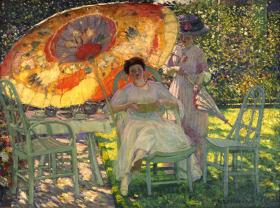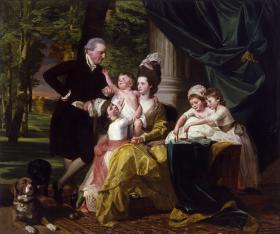1. Provide each student with a copy of the Image Analysis Chart. Assign the class to examine Sir William Pepperrell and His Family, The Garden Parasol, and Sunday, Women Drying Their Hair. Ask students to record their observations on the Image Analysis Chart.
2. Allowing students to look at their Image Analysis Charts, hold a class discussion focused on the following questions:
• Who are the women in each of these paintings?
• Are they rich? How do you know?
• Are they married or single? How do you know?
• What deductions can you make about how women were viewed in the American past? (from the late 18th to the early 20th century)
3. Assign each student to think of a woman they believe to be of significance in American History. Have them research the impact the woman made on her society and the conditions in which she lived.
4. Assign each student to create a portrait of that woman using any materials. Encourage students to choose details that accurately reflect the woman’s identity, status, and impact, including setting, clothing, props, and activities.
5. Encourage students to display their portraits and explain how their illustrations reflect their subjects’ status and role in American society.
• Successful completion of the Image Analysis Chart will demonstrate students’ ability to analyze and deconstruct artistic images.
• Active participation in class discussion will demonstrate students’ ability to use artistic analysis as a means to understand social and economic structures within the context of American history.
• Completion of an illustration of a significant American woman, including elements that reveal her role and status, will demonstrate students’ ability to explore a concept creatively through artwork.
• The teacher may use an art rubric to assess each student's illustration.
composition
identity
mood
portrait
portrayal
setting
status
subject
colored pencils, markers, paper
When asked his artistic goals, Frederick Frieseke declared, “it is sunshine, flowers in sunshine; girls in sunshine.” The emphasis upon light marks Frieseke as a disciple of the Impressionists. However, in contrast to the Impressionists, he focused his attention not on landscape but on the female figure and the private lives of women.
The Garden Parasol evokes the serene pleasure of a summer in the French countryside. The setting is the garden of the Friesekes’ house at Giverny, close to the home and gardens of the impressionist painter Claude Monet. The seated woman is the artist’s wife, Sarah, and the garden was her special creation. Frieseke depicts her as a cultivated woman of leisure whose reading is interrupted by the arrival of a visitor-or visitors, for it is our approach that distracts Mrs. Frieseke from her book and prompts her to fix us with a questioning stare. Whatever small drama might arise from so genteel an encounter is fully upstaged by the vibrancy of the garden, and especially by the Japanese parasol that spices the scene with swirling colors.
John Singleton Copley was never content with being the finest portrait painter in a provincial outpost of the British Empire. While building his career and fortune in Boston, he dreamed of making the voyage to Europe to study the works of the old masters and prove himself against the best of London's painters. Finally, in 1774, after years of indecision, Copley left for Europe.
After a study tour of Italy, Copley and his family settled in London, where he set about the daunting task of establishing himself as a painter of the front rank. As might be expected, a number of his earliest patrons were fellow Americans, including Sir William Pepperrell (1746–1816), who had arrived in London a year after Copley. Sir William was the grandson and heir of William Pepperrell (1696–1759), a prosperous merchant, politician, and soldier, and the first native-born American to be awarded the title of baronet. The younger Pepperrell further enhanced the family's stature by marrying the daughter of Isaac Royall, one of the wealthiest men in British America.
However, during the turbulent years leading up to the American Revolution, Pepperrell remained steadfastly loyal to the British Crown. Fearing mob violence and the wholesale confiscation of his property, he sailed from Boston with his family toward an uncertain exile. Soon after arriving in 1775, Pepperrell commissioned Copley to paint a family portrait. When finished, the painting was more than the standard, flattering celebration of a proud, illustrious family. It also symbolized with poignant irony the tragedy of the Pepperrells.
No doubt in accord with the wishes of his client, Copley staged an extravagant, yet intimate portrayal of Sir William, his wife, Elizabeth, and their three daughters and newborn son. He invented a setting that is neither a proper interior nor a landscape, but a studio fantasy. The colossal fluted column, Baroque drapery, plush "Turkey" carpet, and the inviting glimpse of a twilight park were stock devices in royal and aristocratic portraiture, signifying wealth, refinement and power.
Unfortunately, the portrait is an elaborate fiction, designed by client and artist to mask an unacceptable reality. The Pepperrells were not English upper class, but American exiles who had lost much of their fortune. Moreover, Elizabeth Royall Pepperrell had died in Boston two years before the portrait was painted. (For her likeness, Copley probably relied upon a portrait miniature.) For the widower and his children, Copley offered a comforting vision of what might have been, had not war and death come knocking.



